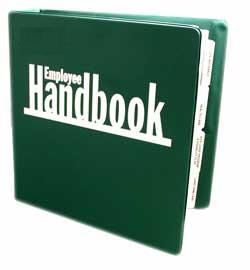If you are in business, chances are that you have at least one employee. In today’s litigious society, it’s often desirable to have a clear outline of expectations of employees and company offerings. One way to establish these expectations is through the creation of an employee handbook detailing the employment laws, policies, conduct of business practices, and benefits.
society, it’s often desirable to have a clear outline of expectations of employees and company offerings. One way to establish these expectations is through the creation of an employee handbook detailing the employment laws, policies, conduct of business practices, and benefits.
While verbal communication to employees is crucial, it is very important to create a clear definition of policies and procedures in writing. This allows for protections by outlining labor laws, hours of work, overtime pay, the physical working conditions and expectations of employees. In order to make sure that all employees are aware of the terms of employment and to avoid any appearance of impropriety or partiality, delivering a handbook and having each employee sign for it upon acceptance of employment is a wise practice to put in place.
What should be included when you create an employee handbook?
Creating an employee handbook may seem overwhelming, however, the majority of labor laws are standard rules that vary from location and city and the company specific items are the rules by which you will govern your business. Listed below are a few examples of areas that are important to decide and then communicate to create a standard culture of your choice.
- About the company: What is your company’s history? What is your mission statement? And what are the goals you hope to attain? What work culture are you creating?
- Compliance with federal rules: Every company with at least 15 employees falls under federal guidelines and must comply with the regulations relating to equal opportunity employment, and non-harassment/non-discrimination. It is also wise in this section to outline the expectations of a drug-free workplace.
- Benefits: The new ACA regulations and various other ordinances in your area now require benefits to be offered. This section is where you will outline health insurance benefits, how vacation rules work and how your company deals with sick leave.
- Employee Status: This is where you will define how an employee is classified (full-time, part-time, on call), pay periods and how they can expect to be paid.Work Performance: It is important to explain how each employee will be evaluated and the expectations for their positions.
- Discipline and termination: If an employee is acting in a way that is contradictory to the policies of the company or legal limits, it’s important to have the grounds for disciplinary action outlined, the procedures for pursuing those actions and the procedures for termination.
- Acknowledgment of receipt: In order to make sure that there is a record of the employee receiving the handbook, it’s important to have them sign a ‘handbook acknowledgement form’. The following disclaimers should be included: acknowledgment that this is not an employment contract, designation of at-will relationship, and the company’s right to revise or terminate any policies at any time, for any reason.
There are some great online resources for how to create an employee handbook. In addition, it would be wise to work with an HR professional to assist with policy creation, benefits offerings, and bringing local expertise to the table as the law varies by location. A good HR consultant has the experience to discuss with you options and industry standards and creative ways to create a good benefit package and culture.
In order to obtain the maximum benefits from your employee handbook, it is vital that those policies outlined in the handbook are consistent with the actions of the company. This will provide you with protection should any legal actions or disputes arise.
Our HR staff is committed to ensuring that your company is able to meet its goals and objectives. Click here for a free consultation to find out how we can support you.

